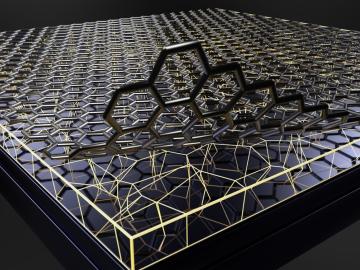
Filter News
Area of Research
News Type
Date
News Topics
- 3-D Printing/Advanced Manufacturing (1)
- Artificial Intelligence (2)
- Big Data (4)
- Bioenergy (1)
- Biology (1)
- Buildings (3)
- Chemical Sciences (3)
- Clean Water (2)
- Climate Change (6)
- Composites (1)
- Computer Science (1)
- Critical Materials (1)
- Decarbonization (3)
- Energy Storage (3)
- Environment (4)
- Fossil Energy (1)
- Grid (1)
- High-Performance Computing (2)
- ITER (1)
- Machine Learning (3)
- Materials (2)
- Materials Science (3)
- Mathematics (1)
- Net Zero (1)
- Neutron Science (1)
- Nuclear Energy (1)
- Polymers (1)
- Simulation (3)
- Sustainable Energy (3)
- Transportation (2)
Media Contacts

Researchers demonstrated that stainless steel and other metal alloys coated with hexagonal boron nitride, or hBN, exhibit non-stick or low-friction qualities along with improved long-term protection against harsh corrosion and high-temperature.

Electric vehicles can drive longer distances if their lithium-ion batteries deliver more energy in a lighter package. A prime weight-loss candidate is the current collector, a component that often adds 10% to the weight of a battery cell without contributing energy.

By frequently changing the Internet addresses of protected servers, Oak Ridge National Laboratory’s Craig Shue has created a technology that thwarts attacks with just minor changes in infrastructure. The system, dubbed Choreographer, makes it difficult for hackers to guess the server’s address whi...

Improving welds of heavy and light armored fighting vehicles is the target of a collaboration among Oak Ridge National Laboratory, the U.S. Army Tank Automotive Research, Development and Engineering Center, and ArcelorMittal USA. While military vehicle designs use high-strength steels, hydrogen-in...

Federal employees and select personnel from national laboratories will gather at Oak Ridge National Laboratory in February for a two-day training session in nuclear forensics. The event, sponsored by the Department of Homeland Security (http://www.dhs.gov/about-domestic-nuclear-detection-office), ...

Using an Oak Ridge National Laboratory technology, inspectors of containers of nuclear material will be able to know with unprecedented confidence whether an intruder has tampered with a seal. The system uses a light source of entangled photons to verify the continuity of a fiber-based seal, accor...






